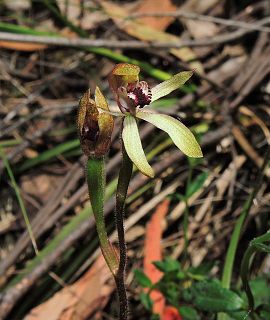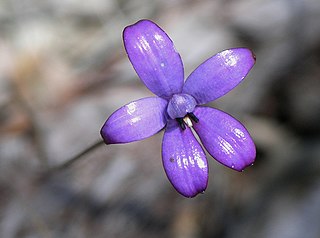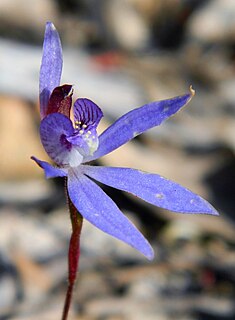
Caladenia latifolia, commonly known as pink fairies is a species of orchid endemic to Australia and is common and widespread in the southern half of the continent and in Tasmania. It has a single, hairy leaf and up to four pink flowers. It is easily distinguished by its relatively large, green leaf, and pink flowers on an unusually tall spike.

Caladenia venusta, commonly known as the graceful spider orchid, large white spider orchid, or simply white spider orchid is a plant in the orchid family Orchidaceae and is endemic to southern Australia. It is a ground orchid with a single leaf and one or two white to cream-coloured flowers with drooping, brown, thread-like tips.

Caladenia gracilis, commonly known as musky caps or musky caladenia, is a plant in the orchid family Orchidaceae and is endemic to eastern and south-eastern Australia, including Tasmania. It is a ground orchid with a single leaf and up to six flowers which are dark-coloured on the back and white on the front, sometimes tinged with pink and with a strong musky or soapy odour. The species is also known as Caladenia moschata in Victoria.

Caladenia atrovespa, commonly known as the thin-clubbed mantis orchid, is a plant in the orchid family Orchidaceae and is endemic to New South Wales. It is a terrestrial, perennial, deciduous, herb with an underground tuber and a single hairy leaf. The species was first formally described by David Jones in 2008 and given the name Arachnorchis atrovespa from a specimen collected on Black Mountain in the Australian Capital Territory. The description was published in The Orchadian. In 2010, Gary Backhouse changed the name to Caladenia atrovespa. The specific epithet (atrovespa) is derived from the Latin words atra meaning "black" and vespa meaning "wasp".

Caladenia hildae, commonly known as golden caps, honey caladenia or honey hood is a plant in the orchid family Orchidaceae and is endemic to the south-east of mainland Australia. It is a ground orchid with a single leaf and up to four yellowish-brown to golden-brown flowers with darker tips on the sepals and petals.
Caladenia incensum, commonly known as the glistening spider orchid is a species of orchid endemic to the south-west of Western Australia. It has a single, hairy leaf and three glistening white flowers which have a red-striped labellum.

Caladenia iridescens, commonly known as bronze caps or bronze caladenia is a plant in the orchid family Orchidaceae and is endemic to Victoria. It is a ground orchid with a single leaf and one or two dusky red, purplish to greenish-brown flowers, often with golden tints and greenish to brownish on the back.
Caladenia leptochila subsp. dentata, commonly known as the toothed spider orchid, narrow-lipped spider-orchid or narrow-lipped caladenia, is a plant in the orchid family Orchidaceae and is endemic to South Australia. It has a single leaf and one or two mostly reddish-brown flowers. It differs from subspecies leptochila in the colour of its flowers, toothed edges to its labellum, and its distribution.

Caladenia moschata, commonly known as musky caps or musky caladenia, is a plant in the orchid family Orchidaceae and is endemic to eastern and south-eastern Australia, including Tasmania. It is a ground orchid with a single leaf and up to five flowers which are dark-coloured on the back and white on the front, sometimes tinged with pink and with a strong musky or soapy odour. The species was previously known as Caladenia gracilis.

Caladenia praecox, commonly known as early caladenia or early caps is a plant in the orchid family Orchidaceae and is endemic to south-eastern Australia. It is a ground orchid with a single leaf and up to four white flowers which are often tinged with green or pink.

Caladenia rhomboidiformis, commonly known as the diamond spider orchid, is a species of orchid endemic to the south-west of Western Australia. It has a single erect, hairy leaf and one or two green, yellow and red flowers. Until 1971 It was known as a variety of the green comb spider orchid Caladenia dilatata then, until 1989 as a variety of the clubbed spider orchid, Caladenia longiclavata.

Caladenia testacea, commonly known as honey caps, or honey caladenia is a plant in the orchid family Orchidaceae and is endemic to New South Wales. It is a ground orchid with a single, sparsely hairy leaf and up to three white to yellowish-green flowers with brownish tips and a darker back.

Caladenia transitoria, commonly known as green caps, is a species of orchid endemic to south-eastern Australia. It has a single, long, erect, hairy leaf and one or two greenish-yellow flowers with purplish backs.

Caladenia valida, commonly known as the robust spider orchid, is a plant in the orchid family Orchidaceae and is endemic to south-eastern continental Australia. It is a ground orchid with a single sparsely hairy leaf and up to three white to cream-coloured flowers which sometimes have red streaks. It is similar to Caladenia reticulata but is large and taller with more stiffly spreading lateral sepals and petals.

Caladenia brunonis, commonly known as the purple enamel orchid, is a plant in the orchid family Orchidaceae and is endemic to the south-west of Western Australia. It is a ground orchid with a single flattened, hairy leaf and up to three glossy purple flowers. It has recently been known as Elythranthera brunonis since 1963 but recent discoveries suggest its inclusion in the genus Caladenia.

Caladenia caerulea, commonly known as the eastern tiny blue china orchid, blue caladenia or blue fairy is a plant in the orchid family Orchidaceae and is endemic to eastern Australia. It has a single narrow leaf and a single blue flower.

Caladenia gemmata, commonly known as the blue china orchid, is a plant in the orchid family Orchidaceae and is endemic to the south-west of Western Australia. It has a small, oval leaf and up to three intense blue to mauve flowers. It is the most common and widespread of the West Australian china orchids, sometimes appearing in large numbers after summer fires.
Caladenia gertrudae, commonly known as the pale china orchid, is a plant in the orchid family Orchidaceae and is endemic to the south-west of Western Australia. It has a small, oval leaf and one or two pale blue, sweetly-scented flowers. It is similar to Caladenia gemmata but its leaf is green on both surfaces, the flower is scented and the labellum is striped.

Caladenia sericea, commonly known as the silky blue orchid, is a plant in the orchid family Orchidaceae and is endemic to the south-west of Western Australia. It is a common orchid in the high rainfall areas of the state and has a single, broad, silky leaf and up to four blue-mauve flowers.

Caladenia major, commonly known as the waxlip orchid, parson-in-the-pulpit, or purple cockatoo is a plant in the orchid family Orchidaceae and is endemic to Australia. It is a ground orchid with a single hairy leaf and one or two purple to mauve flowers. It has been known as Glossodia major since its description by the prolific Scottish botanist Robert Brown in 1810, but recent discoveries suggest its inclusion in the genus Caladenia.



















